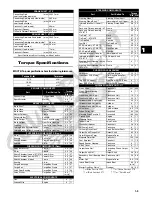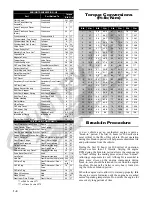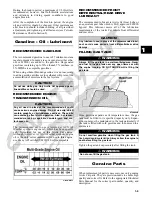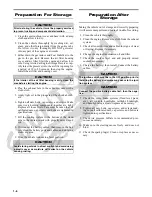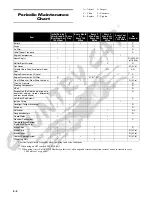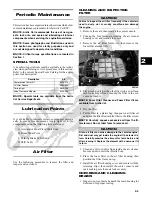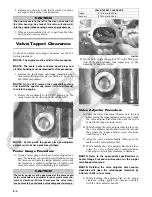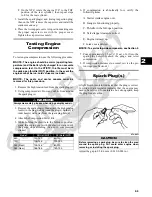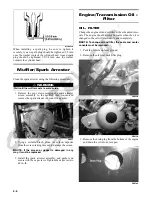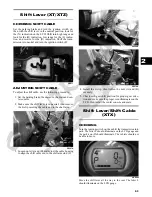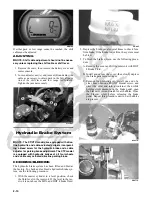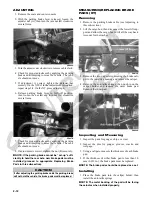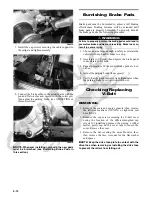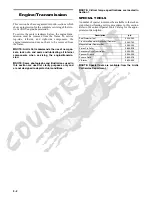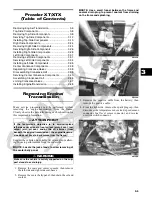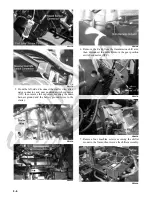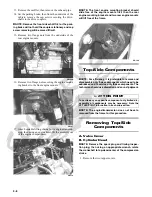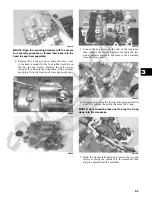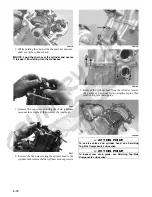
2-11
2
NOTE: During the bleeding procedure, watch the
reservoir very closely to make sure there is always a
sufficient amount of brake fluid. When the level falls
below MIN, refill the reservoir before the bleeding
procedure is continued. Failure to maintain a suffi-
cient amount of fluid in the reservoir will result in air
in the system.
D. At this point, perform steps B and C on the other
FRONT bleeder screw; then move to the REAR
bleeder screw(s) and follow the same procedure.
E. Repeat steps B and C until the brake pedal is firm.
4. Carefully check the entire hydraulic brake system
that all hose connections are tight, the bleed screws
are tight, the protective caps are installed, and no
leakage is present.
INSPECTING HOSES
Carefully inspect the hydraulic brake hoses for cracks or
other damage. If found, the brake hoses must be replaced.
CHECKING/REPLACING PADS
The clearance between the brake pads and brake discs is
adjusted automatically as the brake pads wear. The only
maintenance that is required is replacement of the brake
pads when they show excessive wear. Check the thick-
ness of each of the brake pads as follows.
1. Remove a front wheel.
2. Measure the thickness of each brake pad.
PR376A
3. If thickness of either brake pad is less than 1.0 mm
(0.039 in.), the brake pads must be replaced.
NOTE: The brake pads should be replaced as a set.
4. To replace the brake pads, use the following proce-
dure.
A. Remove the wheel.
B. Remove the cap screws securing the caliper
holder to the knuckle; then remove the pads from
the caliper.
PR237
C. Install the new brake pads.
D. Secure the caliper holder to the knuckle with new
“
patch-lock
”
cap screws. Tighten to 20 ft-lb.
PR377B
E. Install the wheel. Tighten in a crisscross pattern in
20 ft-lb increments to 80 ft-lb (aluminum wheels)
or 45 ft-lb (steel wheels).
5. Burnish the brake pads (see Burnishing Brake Pads
in this section).
BRAKE DISC
Using a micrometer, measure the thickness of the brake
disc in the contact surface. If thickness is 0.125-in. or
less, the disc must be replaced. To replace the brake disc,
see Section 6 – Hub.
Parking Brake (XT/XTZ)
CHECKING
Although the parking brake has been adjusted at the fac-
tory, the brake should be checked for proper operation.
The brake must be maintained to be fully functional.
1. With the engine off, transmission in neutral, and the
parking brake set, attempt to move the vehicle.
2. If the rear wheels are locked, it is adjusted properly.
3. If the rear wheels are not locked, it must be adjusted
(set up).
CAUTION
This hydraulic brake system is designed to use DOT 4
brake fluid only. If brake fluid must be added, care must
be taken as brake fluid is very corrosive to painted sur-
faces.
Содержание 2013 Prowler XT
Страница 1: ...Prowler XT XTX XTZ ...
Страница 3: ......
Страница 5: ......
Страница 149: ...4 16 NOTES ...
Страница 211: ...7 8 NOTES ...
Страница 232: ...8 21 8 NOTES ...
Страница 233: ... Printed in U S A Trademarks of Arctic Cat Inc Thief River Falls MN 56701 p n 2259 530 ...

